#redemption rooted in mythology.
Explore tagged Tumblr posts
Text
youtube
The Dark Secret of Heracles: What Drove the Hero to the 12 Labors
A crime, a hero, and a tragedy: what truly compelled Heracles to undertake his immortal deeds?
Heracles is remembered as the greatest hero of Greek mythology, a symbol of strength and courage. Yet behind his legendary achievements lies a story few know—a journey of suffering, vengeance, and redemption. This video unveils the origins of his 12 Labors, delving into hidden secrets and the impossible challenges he faced to purify his soul. Discover how fate, the jealousy of the gods, and human rivalries intertwine in an epic tale that defined the humanity of an immortal hero. Get ready for a journey into the myths like never before!
#12 Labors#Eurystheus#Greek deities#Greek legends#Greek mythology#Greek tragedies#Hera and Heracles#Heracles#Hercules#Zeus and Heracles#ancient heroes#ancient stories#fate and redemption#legend of hercule tas#legendary feats#myth of Heracles#mythic heroes#redemption rooted in mythology.#secret life of bees hero's journey#secret of bone hill review#secret of the hero botw#youtube#atrumvox#mythology#videos#fantasy#Youtube
1 note
·
View note
Note
Hi! If requests are still open can i request mk1 men with an angel reader? Thanks!
author note: Earthrealm guys for my own sainty🫡
Johnny Cage: -"Have you fallen from Heaven? Cuz' you are an angel." "It's exactly what happened." "…Seriously? We should totally make-" "No." -The man is so curious. -He flirts here and there, but mostly, he just wants to know how angels work and how it is up there. -Maybe some juicy info will slip, and Johnny will be able to make a movie out of it…
Kenshi Takahashi: -When everybody told him you are an angel, Kenshi thought you were just a nice person. -When Johnny told him you are an angel, Kenshi thought you were also beautiful. -For sure, Kenshi never thought of feeling feathers when you protected him during a fight. -"So you are an angel." He says, breathless. "Yeah, nobody told you?" -"Will my sins be forgiven?" "My Lord welcomes every sinner seeking redemption."
Raiden: -Literal angel meets metaphorical angel. -Every time you two meet in the same room, you make it shine for how nice and good you both are. -You are both so sweet that Lao swears that some of his teeth rooted. -"Can I touch them?" "The wings?" Raiden nods. -Best experience ever: 10/10. It felt like caressing a cub and heart is relaxed better than any medicine could ever do.
Kung Lao: -"You are wayyy too nice." "I'll take it as a compliment." -He teases you restlessly, Lao wanna see the angel snap back at him. -If only he knew what you went through, he'd understand that his chances are less than zero. -The real surprise will be when you'll tease him. -"You are so cute when you blush, Lao." "????" -He is going to get you back for this.
Liu Kang: -"Do not be afraid." "Did you just steal my line?" -You are not the first angel he has seen, but it's been so long since he has been in contact with one that he'll try to keep you as long as possible on Earthrealm. -"Your presence has been healing for everyone. They hope you'll stay here for much longer." "Aren't you sure that "they" isn't just you, Liu Kang?" -Seeing him choke on his tea was a real sight, almost heavenly.
Geras: -It's not the first time Geras meets an angel, so he won't be surprised by you. -He likes to chit-chat, tho! You are both so old you for sure have a lot of stories to tell to each other. -Geras appreciates your help keeping the timelines safe, so he'll always be ready to give you a hand if you need it.
Bi-Han: -"What should I be afraid of? You are nothing more than a mythological chicken." Shows angelic true form "…fuck" -He won't treat you with any respect unless you defeat him in a fight. -Your true form will haunt him in his nightmares, tho. -"Repent Bi-Han." -Maybe an angel is the push he needs.
Kuai Liang: -He is so respectful to you, bowing every time he greets you. -Wouldn't mind training with you, and don't you dare go easy on him! -"Are my flames as hot as hell ones?" "Dear, I'm sorry, but I'm not a fallen angel. For sure, your smile is bright as our light." -Congrats! You made Liang blush, shy smile on his face making him uncharacteristically cute.
Tomas Vrbada: -"Have you fallen from Hea-" "Sorry Tomas, Johnny already tried it." "Damn it!" -Tomas looks so sweet that he reminds you of your brothers. -Too bad that then you remember his work… -He is really curious so you'll be asked a lot about your past and family. -"Are my mom and sister fine?" "I'm sorry Tomas I can't reveal anything. But relax, they are in good hands."
#mk x reader#mk1 x reader#mortal kombat x reader#mk headcanons#mk1 headcanons#mortal kombat headcanons#johnny cage#johnny x reader#kenshi takahashi#kenshi x reader#mk1 raiden#raiden x reader#kung lao#kung lao x reader#liu kang#liu kang x reader#geras#geras x reader#bi han#bi han x reader#kuai liang#kuai liang x reader#tomas vrbada#mk1 smoke#tomas x reader#smoke x reader
649 notes
·
View notes
Text
DPXDC Idea: Mother of Monsters Dan(yal)
Specifically Fem!Dan because I made this in mind with my Fem Danyal Au bUT. The best part about Dan is that I get to play dress up with her, and Fem Dark Dany is gonna go by Layal (pronounced lae-el) because it means "the nights" and it sounds similar to Danyal, and I think she'd choose that name to mock Dany. ANYWAYS
Mother of Monsters Danyal. She may be evil but she's an Al Ghul at her core (even with vlad's soul merged with hers - however, considering that Layal looks and sounds like Dany, she considers that soul to be the more dominant one.) and loves animals. And she might be heartless, but she adores the monsters of the infinite realms.
Mother of Monsters Layal who hates everyone but utterly dotes and adores on every manner of beast she comes across. Stealing the eggs and infant young beasts of the Infinite Realms to raise as her own because she wanted them. Her own island full of monsters, a monstrous menagerie of her own. She steals most often from poachers or exotic pet keepers and other menageries -- the full grown beasties can keep their young.
And with every monster she raises, she can shapeshift their features onto herself, allowing her to change her shape from humanish to any matter of monster or hybrid creature. She calls herself their mother, and them her children. Her precious little babies, capable of incredible mass destruction and mayhem.
From little griffins the size of kittens, to stymphalian vulture chicks, and leviathan young hatching from eggs the size of her pinkie, to creatures native of the ghost zone that didn't even have names in the living realm. There really wasn't a limit to what or who she would take in and she didn't limit herself to any form of mythology. If they were beasts and they were unwanted, she wanted them. And as such, amassed her own mini army of "children" willing to listen to her any command.
Earth doesn't know what hit it when she attacks them.
There are many monstrous forms she could take on, the first one I've thought of is a combination of various serpentine/reptilian features. The body of a naga -- her lower half long and serpentine, her upper still human -- with spiked fins connecting from the bottom of her arms to her sides, ever seen Sinbad where Eris goes "you might have seen my likeness on the temple walls" and her arms do that fin thingy? Same concept. Her hands are webbed and taloned, perfect for slicing through the skin of the living, and her teeth are needle-sharp and shark like. Her hair can either be spiny and feathery-like like the spines of a lionfish, or frilled like a frilled-neck lizard. It's perfect for dealing and doting on her reptilian and amphibian-inclined darlings.
I'm more of a fan of aus where Dan is a sibling of Danny's rather than their kid, so Layal's redemption(..?? probation?) proceeds with her legally becoming Danyal's "twin" sister, who had been lost to the foster system before the Fentons adopted Dany, and was only recently reunited with her. The two of them look so alike that the lie is easy to take root and spread.
Layal is very indignant to the fact that she's now ten years in the past and has to restart her menagerie all over again. Do you know how much blood and sweat went into raising those children? How dare you separate them from their mummy. Although she'll admit she does miss their juvenile years, so she won't mind (too much) needing to raising them again. Dany is helping her retrieve all of them though, dammit.
long story short: epic the musical's "Scylla" has a CHOKEHOLD on me and this is the result of it
Unlike her Dan counterpart, Layal's voice is dancing and sirenic. It's purposely alluring and motherly, in order to lure people into a false sense of security until she feeds them to her "children." Echidna doesn't have shit on her. She almost seems friendly and reasonable, until you get too close and realize it was all an act and she drops it to metaphorically swallow you whole. She's like an anglerfish that way. She and Dany both sound like Scylla from Epic.
#mother of monsters danny#dpxdc#danny fenton is not the ghost king#dp x dc#dpxdc crossover#dp x dc crossover#dpdc#dpxdc au#dpxdc prompt#fem danny fenton#fem danyal al ghul#danyal al ghul#dany helps laya find one(1) beastie and instantly falls in love. laya does not need to convince her to come help her rob other ghosts blind#of their exotic “pets” or animals or whatever the reason they have beasts that they shouldn't for. she'll volunteer willingly its a trait#that they share. laya knows that raising her babies will be difficult now that she has to g back to *school* but dammit se's not leaving#them in the hands of the people she found them in. those are HER children fuck you.#Layal is the one to reveal to Damian that his older sister is alive and it was on purpose. It was to send him on a wild goose chase looking#for Dany in order to be around to save her from becoming Layal.#'Tragic. Terribly tragic; your dear sister had her soul ripped from her body and merged with another. What was left of her...'#'well. i put out of its misery.' she's very cloying towards damian and this is on purpose because she thinks its funny to get under his ski#goes out of her way to only ever refer to him as 'little brother' but if she can't she'll call him sickeningly sweet nicknames.#this happens about oooo midway 'redemption'? Where Laya is actually rather fond of Dany and is starting to consider her as a sister#as well. and she likes Ali. Laya herself is still rather unsympathetic to the world around her. only acts on a kindness for 'her people'#her people includes Dany which is why she even actually told Damian that Dany was alive and gave him an incentive to look for her#because she saw DAny mourning another lost birthday for her little brother and decided to go 'aw fuck who gave me feelings' and decided to#make it everyones problem.#starry rambles
240 notes
·
View notes
Text
Ik that this probably isn’t a new take, but I haven’t seen it talked about enough: I think the reason why so many Star Wars fans dislike the Acolyte is because the fan base is dominated by men and the genres that the Acolyte occupies tend to attract female audiences. Star Wars started out as an action-adventure sci-fi story which are genres that attract male audiences and features the Hero’s Journey which has roots in ancient mythologies and is often accompanied by the main character transitioning from boyhood to manhood. However, the Acolyte is dark romance mystery/suspense story, which not only attracts a more feminine audience, but is also (to an extent) the exact thematic opposite of the stories that men typically read/watch.
The interesting result of the audiences being used to different genres is that they identified different characters as the focal character. Male and action/adventure accustomed viewers picked out Sol as the hero of the story as he at first seems like the most heroic and likely to go on a Hero’s Journey; female and dark romantasy/mystery accustomed audiences, however, saw Osha as the main character because she resembles the classic YA Fantasy protagonist (sources: instagram posts and other random opinions I’ve come across). Episode 3 painted the Jedi in the best possible light and Mae and the witches in the worst possible light, and while female audiences immediately identified it as an unreliable narrator moment, male audiences took it at face value and thus assumed the inconsistencies of the witches’ deaths and Mae’s motives were careless writing. Then, when the Jedi’s actions weren’t painted as heroics, the criticism from male fans shifted away from the writing being poor to the show “glorifying” the Sith and breaking down the Jedi=good Sith=evil dynamics, while the female fans began getting excited for Osha’s corruption and Mae’s redemption.
So, in conclusion, this show is just a different genre than the rest of Star Wars and men need to just accept the fact that they were not the target audience.
#the acolyte#star wars the acolyte#star wars#the jedi#the sith#dark romance#hero’s journey#master sol#mae aniseya#osha aniseya#the force is female#I wrote this over the course of a week so this may be completely incorrect#if it is I’m sorry
190 notes
·
View notes
Text
The Mythological Secrets Behind Jibaku Shounen Hanako-kun
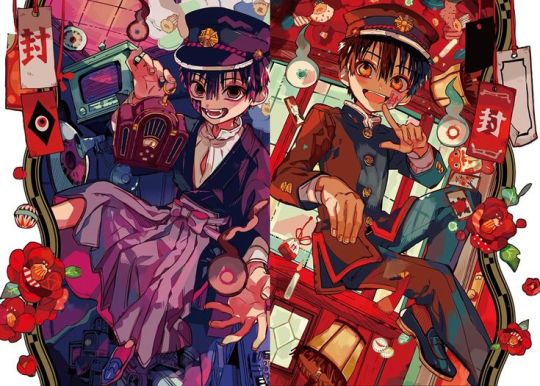
It is not new that we see JSHK rooted in Shintuist culture, along with this culture, we have the classical Gods represented, in addition to, of course, some common items related to this.

But there are some points in particular that I wanted to delve into a little and the similarities represented. But, first of all, let's connect the reasoning to the main points before we get to the Gods.
The thread of the story
1 - Tsukasa's fate = sacrifice himself, he sacrifices himself and stays in the house (If he can see supernatural things, then he was close to death, as mentioned by Hanako, people can only see supernatural things if they have a sixth sense (like exorcists) or when death is close).
2 - Nene and Kou finds the red house and convinces him to come back.
3 - Tsukasa comes back.
4 - Temporal paradox.
5 - Creates an alternative timeline full of errors and chain consequences (causing deaths of people who shouldn't die).
6 - At some point Amane decides to kill the family (theory) and sets the house on fire.
7 - It creates a "curse". (everyone who enters the house dies or disappears).
8 - Somehow Hanako becomes a supernatural being and loses control or does something really bad at some point, to the point where the Minamotos have to seal him and create the seven mysteries.
9 - Kako had to go back in time for some reason (to make Hanako forget some things).
10 - Hanako now plays a role, the leader, but at the same time he is the traitor (indicating that there are two Gods).
11 - He along with Tsukasa want to break the cycle of yorishiros and free themselves from this "prison" so that they can save themselves, Tsukasa wants to save Amane and Amane wants to save Tsukasa.
12 - So, Tsuchigomori is the guy who destroys the butterfly effect, but for some important reason, he will probably sacrifice himself for something in the end.
13 - And Nene, the "mermaid" girl who has a bond with Hanako. And let's remember that the entity is from the water, the tentacles and the people or their souls screaming on the other side of the window in the last chapter, you can see the air bubbles coming out of their mouths, which suggests that they are in the water.
14 - Entity from the well + tentacles + water = entity/God of the water that grants wishes. Like the classics, where you throw a coin in the well to make a wish.
15 - Hanako gets a mermaid scale and gives it to Nene to create a bond, so maybe the scale is directly linked to the entity. Even though we saw the mermaid, she is still a supernatural being.
16 - The mermaid giving up on Nene after the fish died was like a warning from the entity, since it was Tsukasa who killed it. We saw a giant fish in the window of the red house, so maybe the entity is the strongest supernatural being that can influence the lesser supernatural beings.
17 - So, all connected, Nene being able to remove the seals, being a kannagi, coming from a mysterious family, makes me wonder about her connection with the entity.
18 - The Minamotos know something, and they still "help" Hanako because it seems to be necessary. Teru was happy when the supernaturals disappeared, but he was the one who decided to bring them back, even though he didn't want to.
19 - So, there's a reason for him to keep Hanako, as if it was necessary for him to do something, but Teru tries to keep him under control.
20 - In the end, there are probably two Gods (theory): The God of the yorishiros and the God (entity) beneath the red house.
21 - Hanako should work for the God of the yorishiros to receive redemption, but he is the traitor, that is, he works for the God of the red house, because he intends to save Tsukasa. Therefore, the twins want to remove all the seals to "free" the entity and get a wish.
22 -What we are seeing now is all the yorishiros being removed while we follow the stories of their owners, for now, away from the main story of the twins.
The Gods who represent the twins
Now that you understand where we are in the story, let's move on to the mythological part of things and the connection between the twins and Gods that haven't been mentioned yet.

Amaterasu: She is the Shinto goddess of the sun. The name Amaterasu is derived from Amateru, which means "shining in the sky." Her full name is Amaterasu-o-mi-kami, which means "Glorious Goddess Who Shines in the Sky."
Amane: A name derived from Amaterasu, (not literally, but a name that would resemble the name Amaterasu to show a slight connection with the Sun Goddess) he is also depicted as the sun in some panels of the manga, as well as being the opposite of Tsukasa, the moon.
Tsukuyomi: Also known as Tsukuyomi-no-kami, he is the god of the moon in Shinto and Japanese mythology. The name Tsukuyomi is a combination of the Japanese words moon/month (tsuki) and "to read; to count" (yomu). Another interpretation of his name is the combination of "Moonlit Night". Tsukuyomi is the god of the moon in Japanese mythology, brother of Amaterasu and Susanoo.
Tsukasa: often represented in the manga in some panels as the moon itself, as he himself mentions being the opposite of Amane, who is represented as the sun. The name Tsukasa also refers to the name of the god of the moon, similarly to Amane's name.
The two are siblings in mythology as well.
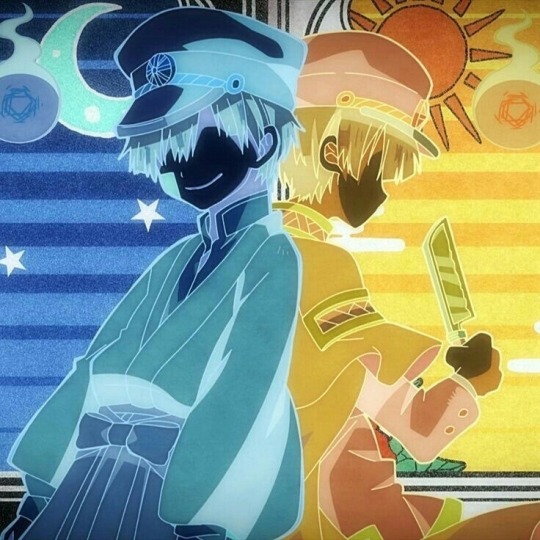
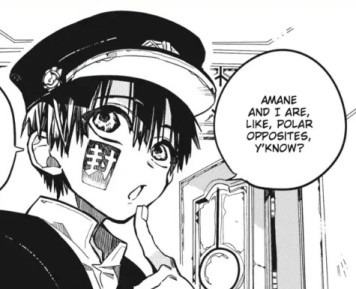
The mythology

The creation myth of the Shinto tradition in Japan is wrapped up in a beautiful and tragic love story between the divine couple Izanagi and Izanami.
Heaven and Earth separated during this long creative process, so Izanagi and Izanami, representatives of what was then the newest divine generation, took on the task of generating life in the immense primordial liquid environment.
Izanagi and Izanami decided to improve their creation, molding the relief with mountains, spreading vegetation to cover the soil and creating rivers to promote fertility.
The rest of creation required carnal acts practiced between Izanagi and Izanami, which has a strong symbolism because it highlights the union between the masculine and feminine for the generation of life and procreation.
They generated divine children after the islands were conceived, each of them associated with important aspects associated with nature.
When Izanami gave birth to Kagutsuchi, the god of fire, she ended up burning to death during childbirth. The father was furious and murdered his son.
Izanagi tried to rescue his beloved from the underworld, the dark Yomi. The exits to Yomi are guarded by terrible creatures and are where the dead go to, apparently, rot for an indefinite period of time. Once fallen there, the soul can never return to the land of the living.
Upon arriving there, Izanami asked her husband not to look at her, to return to Earth and to wait while she tried to escape from Yomi.
The impatient Izanami does not obey and looks at his wife, unrecognizable and with a frightening cadaverous appearance, deteriorated and infested with agents of decomposition.
Now she was a form of decomposing flesh that gave birth to several demons, with worms and demonic creatures slithering over her body. She, realizing her husband's audacity, orders the demons to chase him.
Izanagi flees from the demons, and rolling a huge stone, traps them in Yomi. Izanagi, furious at Izanami's betrayal, uses the powers of the sun to destroy all the demons. Thus began the existence of death, caused by Izanami's pride.
After Izanagi left his wife Izanami, locked in the Shinto underworld of Yomi, he purified himself in a spring and accidentally gave birth to three children.
The sun goddess Amaterasu was born from Izanagi's left eye, the moon god Tsukuyomi was born from his father's right eye, and the god of the sea and storms Susanoo was born from Izanagi's nose.
Where are the similarities in JSHK?
Let's compare.
Mitology
Izanami: Izanami is related to death and she's trapped in the world of Yomi, the world of the dead, she hides her appearance because of her cadaverous form, like she did with her husband.
JSHK
Entity: In JSHK we also don't see the entity, which stays in the dark.


And we have the sacrifices, which are linked to the same reasoning, gradually losing their human form and becoming cadaverous beings.

In JSHK, the entity is said to be very strong, it is weak because it is sealed, "trapped", just like Izanami is trapped in the underworld and cannot return.
Second possibility about the entity
Mitology
Serpent Yamata no Orochi: was a colossal dragon with eight heads and eight tails. According to legend, Yamata no Orochi terrorized the Izumo region, demanding that a young girl be sacrificed to him every year.
In the story, a couple's daughters were sacrificed, leaving only the youngest one alive. The dragon was killed by Susanoo when he tried to save the young woman from being sacrificed. He fell in love with her and married her.
JSHK
The entity demands sacrifices with young women, usually from the same family, since Kannagis come from families that offer to give one of their daughters for sacrifice.
The representation of marriage and Sumire may be linked to the meaning of Sumire's desire to be saved, directly reflected in the mythology of the serpent.

When Suzanoo fell in love with the woman who was going to be sacrificed, he saved her and got married with her.
In Sumire's case, she was not saved and did not marry Hakubo, as she wished. A tragic version of the story.

Implying that the entity of Sumire's time was perhaps the serpent.
Let's continue with the comparisons.
Mitology
Izanagi: He was responsible for imprisoning Izanami in the world of the dead, and tried to keep her imprisoned.
JSHK
The God of Yorishiro: the one who values maintaining seals and mysteries, apparently to keep "something" imprisoned, implying that it is in fact the entity of the red house that is officially sealed.

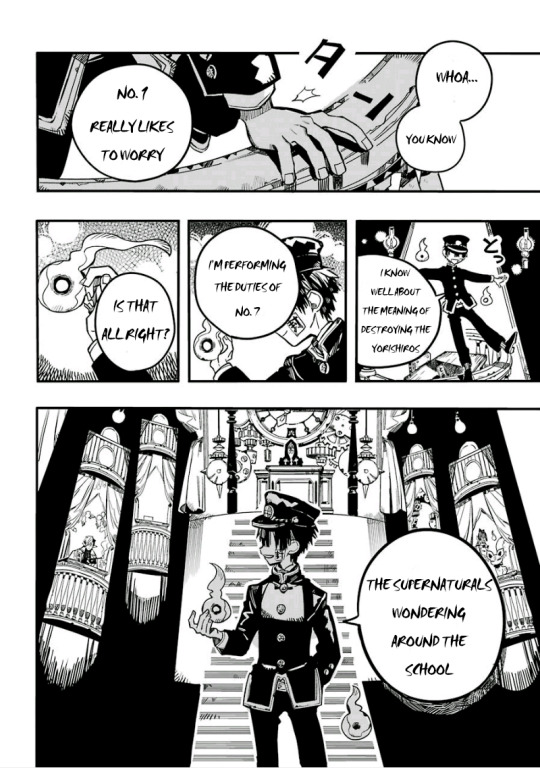

Let's continue with the comparisons.
Mitology
Susanoo: Susanoo is the god of the sea and storms, son of Izanagi and brother of Amaterasu, the goddess of the sun, and Tsukuyomi, the god of the moon.
JSHK
Yashiro: Often depicted as a mermaid and having a direct link to Hanako because of the scales, we can associate her with the myth of Susanoo.

We may still have doubts about Nene's association with him, but Suzanoo had a direct connection with Amaterasu (the sun goddess we are representing as Amane).
At a certain point, Suzanoo goes to Amaterasu's house to resolve a conflict between them.
To link this to JSHK, if you notice, when Hanako throws Nene in fish form into the sky (at the end of the anime) a small storm appears.

Some people theorized that it represented her crying, but at the end, the clouds appear next to the sun and the rain begins. Representing the "storm".
Furthermore, Susanoo is the God who saves the young woman from being sacrificed to the serpent. We see this represented in the moment when Nene is the only one who can "save" Sumire from being devoured by Hakubo, but in this case, she does not. Referring again to the tragic side of mythology and Sumire's story.


Let's continue with the comparisons.
Mitology
The red house and yomi
Yomi is the Japanese word for the world of the dead in Japanese mythology and Shintoism. Its exits are guarded by terrifying creatures and it is where the dead go to apparently rot for an indefinite period of time. Once fallen there and fed in the fire at the center of Yomi, the soul can never return to the land of the living.
Similar to the red house specifically over the abyss where the sacrifices that fell began to rot and could not return.
Water as a Symbol of Transition and Cleansing


Water plays an important role in the series, particularly through its association with Hanako’s past and its connection to bathrooms and wetlands – liminal places between the world of the living and the dead. In Shinto, water is a symbol of purification and renewal, something that is also explored in the story of Hanako, a spirit trapped by regrets who seeks redemption.
The aquatic environment can be interpreted as an allusion to Susanoo, a deity associated with the sea and storms.
Light and Darkness – Themes of Life and Death
Just as Amaterasu represents light and order, some elements of the series suggest a cycle between hope and despair, or redemption and regret. Hanako-kun is a spirit who carries both light (his moments of affection for Nene) and darkness (his tragic secrets and violent past). This duality may echo the myth of Amaterasu, where light and darkness must find balance.

The Seven Mysteries as Guardians and Forces of Chaos
Just as the kami (gods) of Japanese folklore have different personalities and roles, the Seven Mysteries in the series play specific roles that resemble the forces of nature. Some are benevolent and seek balance, while others represent chaos and danger. This multiplicity is characteristic of Japanese myths, where there is no clear division between good and evil.
Although Jibaku Shounen Hanako-kun does not directly mention Amaterasu or Susanoo, the themes of water, purification, light, and darkness found in the series can be seen as a subtle reference to these gods and the natural forces they represent.
In addition, we must add urban legends.
Influences of Japanese Folklore on Hanako-kun
Seven Mysteries of School (七不思議, Nana Fushigi) One of the main inspirations for the series are the legends of the "Seven Mysteries of School," popular stories told among Japanese students about supernatural occurrences that happen in schools. Each mystery usually involves ghosts or strange events, and each school may have its own versions.
In the Hanako-kun universe, these Seven Mysteries are essential, as the spirits that govern each of them have influence over the spirit world and the school.
Spirit World and Boundaries Between Realities In Hanako-kun, there is a strong separation between the world of the living and the spirit world. Places in the school, such as bathrooms or forgotten rooms, function as portals that connect these two worlds. This idea reflects the traditional Japanese concept that certain places, such as temples, cemeteries, or ruins, are meeting points between the physical and spiritual worlds.
Supernatural Elements Inspired by Yōkai and Spirits
Many of the characters and creatures featured in the series are based on or inspired by yōkai (supernatural creatures) and onryō (vengeful spirits) from Japanese folklore. The series also introduces concepts of its own, such as:
Tsukumogami: Ancient objects that gain life and consciousness after 100 years. Some characters in the series resemble this idea, as spirits are tied to specific places or objects in the school.

Onryō: Hanako is a spirit with a tragic past, reflecting the idea of vengeful ghosts or those trapped on Earth due to unresolved regrets.
Akuma and Mononoke: Some spirits are aggressive and need to be purified or controlled, as is the case with several antagonists in the series.
Spiritual Hierarchy and the Conflict Between Mysteries Within the story, the Seven Mysteries have a hierarchy and follow specific rules that govern the coexistence of humans and spirits. The main conflict of the series arises when the mysteries begin to rebel, seeking to change these rules and gain more power. This hierarchical structure is an original creation of the series, but it recalls the idea that kami and yōkai have their own laws and orders in Japanese folklore.
While Jibaku Shounen Hanako-kun doesn't explicitly follow a specific Shinto or Buddhist mythology (so far), it does draw heavily from Japanese urban legends, the Seven Mysteries of School, and concepts from Japanese spiritual folklore such as yōkai, tsukumogami, and onryō.
The series creates its own mythology by combining these traditional elements with a unique narrative.
Which is particularly fascinating!!
It was a fun journey to find these new details to add to the events of the series. Of course, despite the associations and similarities, don't take anything in this post too seriously or canonical, it's just for fun.
There are probably many more details that still need to be discovered or included, (like the mythology about the Minamoto family, and even some common supernatural beings, like Tsuchigomori, who represents Tsuchigumo, but well, if I talk about all of them, this post will be huge).
For this post, that's enough.
If you've read this far, I hope you've had fun!
#jshk#tbhk#toilet bound hanako kun#jibaku shounen hanako kun#amane yugi#hanako kun#aidairo#yugi twins#hanakokun#jshk spoilers#tsukasa yugi#tbhk tsukasa#jshk tsukasa#yugi amane#yugi tsukasa#mitology jshk
134 notes
·
View notes
Text
Origin of the names of the 7 kingdoms of Hell
Ever wonder where do the names of the kingdoms (or regions) of Hell come from? Let's find out in this trivia post :3
WARNING, this post contains religious theme. If you feel comfortable, please ignore this.
Gehenna
"Gehenna", in the Bible and in real life, was originally the name of the valley of Hinnom, outside of the city of Jerusalem. In this valley, many committed the gruesome sin of sacrificing children to the god Moloch. Because of this sin, the valley was cursed by the Jews and its name was used to call the final punishing place of the reprobate. In Christianity, "Gehenna" is used to designate the place where all the demons and the damned human will thrown in at the Last Judgement, "the lake of fire", "the unquenchable fire".
Tartaros
"Tartaros", or Tartarus, was originally the term to describe the abyss of torment and suffering for the wicked and the Titans in Greek mythology.
In the 4th century BC, Greek culture and language were spread to all Eastern Mediterranean countries by the conquest of Alexander the Great. Greek became the common language in these countries and remained so for many centuries. The New Testament of the Bible was written in Greek. The term "Tartaros" was adopted by Christianity to describe Hell. Although "Tartaros" doesn't technically appear in the Bible, the associated verb tartaroō ("throw to Tartaros") does. (The verb itself is a shortened form of another verb with similar meaning kata-tartaroō ("throw down to Tartaros").
In the Bible, Tartaros is the place where fallen angels are chained to wait for judgement.
Hades
The name of the underworld in Greek mythology. It was also adopted by Christianity and used to describe Hell. However, different from Gehenna and Tartaros, Hades is a little bit complicated.
Before the work of redemption was completed in Jesus's death and resurrection, the gate of Heaven was closed. So when a someone died, that person would go to Hell (Hades) ragardless of good or bad. However, in Hades, there was "a great chasm", according to the Bible, separating the good and the bad. The good people either didn't suffer or was purified of their venial sins, while the bad people on the other side really did suffer. No one from "the good side" could cross to the other side, and vice versa.
After Jesus died, his soul descended to Hades and released the just who were detained in Hades and brought them to Heaven, while leaving the damned on the other side of the chasm, waiting for the Last Judgement, after which, both Hades and the wicked in it will be thrown into Gehenna "the lake of fire", for eternal punishment.
Abyssos
The name "Abyssos" comes from "abyss", which is also a word to describe Hell. The precise word "Abyssos" does not exist in the Bible or mythology, as far as I know.
Paradise Lost
This country shares its name with the famous work written by the poet John Milton in the 17th century. The poem Paradise Lost is a dramatized version that retells the story of the fallen angels and their role in the fall of Adam and Eve.
Niflheim
The name comes from Norse mythology of the Scandinavian people. Originally, Niflheim was realm of primordial ice and fog, being one of the two primordial realms, the other being Muspelheim, the realm of fire. Later, the realm became the abode of Hel, the daughter of the god Loki, and it became the afterlife for those who didn't die a heroic or notable death, overlapping with another realm in Norse cosmology, Helheim.
Abaddon
In the Bible, "Abaddon" is both a place and an entity. As a place, Abaddon is the place of destruction, the realm for the dead. As an individual entity, Abaddon is described in the Bible as "a king, the angel of the bottomless pit; whose name in Hebrew is Abaddon, and in Greek Apollyon; in Latin Exterminans" - Revelation 9:11
Now "Abaddon" is entirely tied with the meaning of destruction. Abaddon itself means destruction or "place of destruction". The root of the word abad means perish, or destroy. Both the Greek name Apollyon and the Latin name Exterminans mean destroyer.
#what in “hell” is bad?#prettybusy what in “hell” is bad?#whb trivia#whb gehenna#whb tartaros#whb hades#whb avisos#whb abyssos#whb paradise lost#whb niflheim#whb abaddon
131 notes
·
View notes
Text



Ais: Viking Era (about 800–1050 CE)
Description: The Viking culture emphasizes strength, independence, exploration, and a strong warrior culture. Ais' fierce and determined personality aligns well with the Viking ethos of bravery and combat prowess. The Viking Age's focus on personal valor and leadership in battle mirrors Ais' character strengths.
Leander: Victorian England (19th Century)
Description: The Victorian era is characterized by its distinct social norms, elaborate fashion, and a fascination with the occult and the supernatural. Leander's elegant and refined demeanor, combined with his darker, more mysterious undertones, align well with the Victorian fascination with both high society and the macabre.
Mhin: Edo Period Japan (17th Century)
Description: The Edo period in Japan is marked by its isolationist policies, the rise of the samurai, and a flourishing of traditional arts and culture. Mhin’s austere, reserved, and introspective nature fits well within the context of a samurai or an artisan during this period, reflecting the values of honor, precision, and a deep connection to family and traditions.
Kuras: Renaissance Italy (15th Century)
Description: The Renaissance era marks a period of great intellectual, artistic, and cultural growth. Kuras, with his intellectual depth, curiosity, and healing abilities, mirrors the Renaissance man – a scholar, a healer, and a seeker of knowledge and beauty.
Vere: Baroque Era (1600-1750)
Description: The Baroque era is characterized by its dramatic, detailed, and grandiose art and architecture. Vere’s flamboyant and theatrical personality, combined with his enigmatic and seductive nature, aligns well with the baroque emphasis on drama, emotion, and intricate details.
Bonus: Main Character (MC): Medieval Europe (12th Century)
Description: The Medieval era is known for its knights, castles, and chivalric codes, as well as a deep-rooted connection to mythology and folklore. It was a time when many individuals embarked on pilgrimages or traveled in search of remedies. This fits the MC’s background of seeking a solution regarding their curse. The era’s deep religious undertones align well with themes of faith and redemption, healing, and personal growth, honor-driven quests, meeting with different cultures, religions, and social classes.

#verewrites#red spring studios#touchstarved#ts#touchstarved headcanons#touchstarved game#touchstarved oneshot#headcannons#oneshot#vereletters#touchstarved theory#touchstarved theories#touchstarved ais theory#touchstarved vere theory#touchstarved kuras theory#touchstarved leander theory#touchstarved mhin theory#ts theory#ts theories#veresees#ais#vere#mhin#kuras#leander#ais touchstarved#kuras touchstarved#leander touchstarved#mhin touchstarved#vere touchstarved
91 notes
·
View notes
Text
"Nosferatu" (2024)
“Our spirits are one, ever-eternally”: Ellen and Count Orlok in “Nosferatu” (2024)
Historical Feminism Themes in “Nosferatu” (2024)
“Nosferatu” (2024) and the Female Gothic Genre, Paganism and the Occult
“Wuthering Heights” inspiration on “Nosferatu” (2024)
Romanian Folklore in “Nosferatu” (2024): The Strigoi
“The Plague of Nosferatu”: Rats, Witchcraft and Possession in “Nosferatu” (2024)
Why does Count Orlok has his sarcophagus at the chapel of Grünewald Manor in “Nosferatu” (2024)?
Robert Eggers Count Orlok Backstory: An Overview
Tolkien legendarium and "Lord of the Rings: The Rings of Power"
Tolkien legendarium
Understanding Tolkien Legendarium: A Mythology of its Own
Understanding Tolkien Legendarium: The Fall
No, “Evil” doesn’t “loves only Itself” in Tolkien lore
Concerning the “Laws and Customs among the Eldar” chapter in “Morgoth’s Ring”
Mairon, Dagor Dagorath and Arda Healed
“I perceive the Dark Lord and know his mind”: Galadriel, Sauron and Ósanwë
Character Analysis
Galadriel in Season 1-2 of “Rings of Power”: Valiant, Prideful and the Darkness Within
“I have many names”: Halbrand, the Repentant Mairon in “Rings of Power”
Sauron and Gollum parallels in “Rings of Power”
What did Sauron meant by “Not All of It” in 2x08? - Sauron color code analysis
Of Sauron [Hypothetical] Redemption: Is Sauron redeemable?
Galadriel and Sauron in "Rings of Power"
Galadriel/Frodo and Sauron/One Ring in “Rings of Power”
The Physicality of Sauron x Galadriel: Cosmic Connection and Physical Attraction
The Tragedy of Haladriel - Part I
The Tragedy of Haladriel - Part II
Freudian Symbolism: Sauron x Galadriel in Season 1 of "Rings of Power"
Freudian Symbolism: Sauron x Galadriel in Season 2 of "Rings of Power"
Season 2
About Morgoth’s crown
What’s the deal with Sauron and Elrond connection in Season 2?
“Evil Takes Root”: The Temptation and Fall of Galadriel
“Last Temptation” because “only blood can bind”
"Tentgate" Theory
Sauron Masterplan in Season 2
Elrond’s Arrival at Eregion in 2x07
Elrond and Adar in opposite sides of Eregion in 2x07: Visual Evidence
Megathread: All Clues concerning “Elrond = Sauron” in “Adar meeting/Kiss scene” (2x07) - Part I
Megathread: All Clues concerning “Elrond = Sauron” in “Adar meeting/Kiss scene” (2x07) - Part II
Melian of the Valar and Tentgate
Season 3 speculation
Let’s talk 1x08 and 2x08 epilogues and how they set up next season
“some wounds that cannot be wholly cured": hypothetical consequences of Morgoth’s crown wound on Galadriel
20 notes
·
View notes
Text

The Three-Eyed Warrior: Unpacking the Origins and Evolution of Tien Shinhan
Tien Shinhan, the stoic, three-eyed martial artist, stands as a pillar of the Dragon Ball universe. From his initial antagonistic role to his unwavering dedication to Earth's defense, Tien's journey is a testament to perseverance and self-improvement. But where did this unique character come from, and how has he changed over the years? Let's delve into the fascinating origins and evolution of Tien Shinhan.
A Divine Inspiration: The Roots of Tien's Design
Akira Toriyama, the mastermind behind Dragon Ball, often drew inspiration from various sources, including Chinese mythology and folklore. Tien Shinhan's design and abilities are heavily influenced by Erlang Shen, a powerful three-eyed deity from the classic Chinese novel "Journey to the West." Erlang Shen, like Tien, possesses a prominent third eye, granting him enhanced vision and mystical powers. Both characters are renowned martial artists, initially serve as adversaries to the protagonist (Sun Wukong in "Journey to the West" and Goku in Dragon Ball), and eventually become respected rivals and allies.
While the Erlang Shen connection is clear, it's important to note that Toriyama's creative process is a melting pot of influences. He often combines different elements and adds his own unique spin, resulting in characters that are both familiar and refreshingly original.
From Rival to Respected Ally: Tien's Journey Through Dragon Ball
Tien's introduction in the original Dragon Ball series paints him as a formidable antagonist. Initially a student of the Crane Hermit, he embodies a ruthless approach to martial arts, even breaking Yamcha's leg during the 22nd World Martial Arts Tournament. His third eye, initially portrayed as a sign of his dark nature, adds to his intimidating aura.
However, Tien's character arc takes a significant turn. His battles with Goku, particularly during the Fortuneteller Baba saga and the 22nd World Martial Arts Tournament, spark a transformation within him. He witnesses Goku's unwavering spirit and commitment to justice, leading him to question his own path. Tien eventually renounces his master's teachings and embraces a more honorable code of conduct.
From this point forward, Tien becomes a valuable member of the Z Fighters, consistently training to improve his skills and protect Earth. He plays a crucial role in various battles, notably against the Saiyans, Frieza, and Cell. While he may not always be at the forefront of the action, his unwavering dedication and strategic mind make him an indispensable ally.
Beyond Power: Tien's Evolution in Dragon Ball Super
In Dragon Ball Super, Tien continues to demonstrate his commitment to martial arts and self-improvement. While he acknowledges that he can't compete with the Saiyans' ever-increasing power levels, he focuses on honing his own techniques. He establishes his own dojo, teaching students and passing on his knowledge.
Perhaps the most significant aspect of Tien's evolution in Super is his role as a mentor and teacher. He imparts valuable lessons to his students, emphasizing the importance of discipline, focus, and inner peace. This reflects his own journey of self-discovery and his understanding that true strength lies not just in physical power, but also in mental fortitude.
Tien's character development highlights the themes of redemption, perseverance, and the pursuit of self-improvement. He represents the idea that anyone can change and grow, regardless of their past. While he may not possess the god-like power of Goku or Vegeta, his unwavering dedication and his unique set of skills make him an integral part of the Dragon Ball universe. He remains a fan favorite, a testament to his complex character and his enduring spirit.
#tien shinhan#Tien#Tien Dragon Ball#DBZ#Dragon Ball Z#Dragon Ball characters#akira toriyama#dbs#dragon ball super#tien dbz
17 notes
·
View notes
Note
Sephiroth tree of life symbolism is driving me insane-
That one cutscene near the end of the game where Sephiroth is near this a humongous tree near the Forgotten City and that rainbow rift in the sky has me thinking.
And of course he chooses to transform into Bizzaro Sephiroth, in the Forgotten City, NEAR THE TREE.
If the Lifestream and its many worlds represent branches/roots of a tree and that Jenova meanwhile is busy corrupting the Lifestream...
According to Norse mythology, the god Odin hung himself on the world tree to obtain knowledge. Just like how Sephiroth got his knowledge from the Lifestream (or future events).
Then maybe Sephiroth would have to do the ultimate sacrifice. I find it fitting that a villan named after the sefirot will be the one to save everyone at the cost of his life.
This may not happen in Part 3 obviously, but it's a great theory methinks.
🤯🤯🤯
That would be a CRAZY way to end things. Part of me wonders how genuine they're being when they're saying the R Trilogy leads up to Advent Children. If Sephiroth DOES get some form of redemption...do the events of AC not play out the same way? Or is it the remains of the Sephiroth that WAS? Crazy stuff...
#asks#ff7#ffvii#final fantasy 7#sephcanons#sephiroth#final fantasy vii#ff7r#final fantasy rebirth#ffvii rebirth#ff7 rebirth
19 notes
·
View notes
Note
What do you think of Majin Buu's redemption?
Complicated. Buu's arc isn't... I wouldn't really call it a redemption, so much? It's closer to a child learning right from wrong for the first time. Just. Muddied by the extent of the wrongs Buu committed in ignorance.
Morally speaking, Majin Buu is a very complicated character that operates on an eldritch scale. He doesn't map 100% onto a relatable human experience.
The original state of Buu, colloquially known as Kid Buu or Pure Buu, is effectively a mindless killing machine.
Like. That's not to say that he's a zombie or something. Pure Buu demonstrates creative attacks, learns moves from watching others perform them, and is capable of advanced problem-solving.
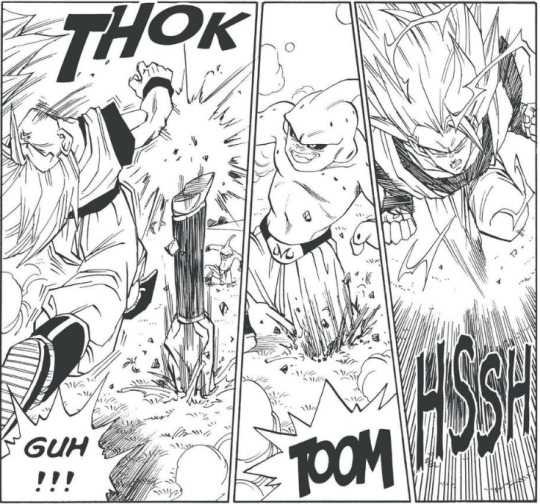
But by the same token, he doesn't really seem... self-aware. Pure Buu's behavior is more akin to a feral beast than a sentient person.
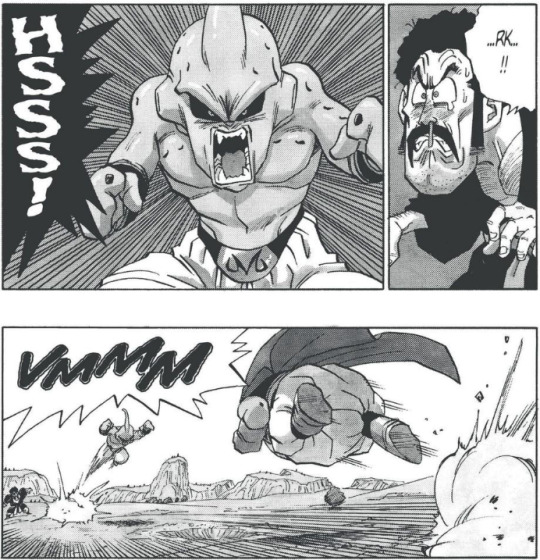
I would compare him to a robot. He's capable of learning, applying knowledge, and working out solutions to obstacles in front of him. But he has no sense of self, identity, or real understanding of the universe around him; Only a program that he uses his comprehension to carry out.
He's making advanced calculations, rather than informed choices. He exists for the singular purpose of purging all things that exist.
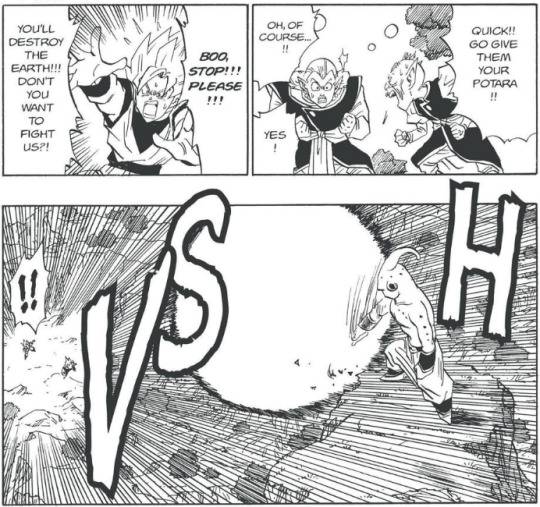
No, Goku. He does not. He is not interested in fighting you. He is not interested in anything. He is executing Annihilation.exe.
The only reason the fight on the Kaioshin world can even happen is because their god-world apparently can't be blown up.
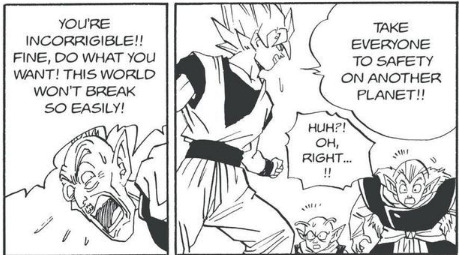
This is what writing yourself into a corner with protagonists who can't breathe in space and a villain who blows up any planet he touches looks like.
Even Buu himself doesn't like this version of him. He practically begs Goku and Vegeta not to erase his identity and personality.
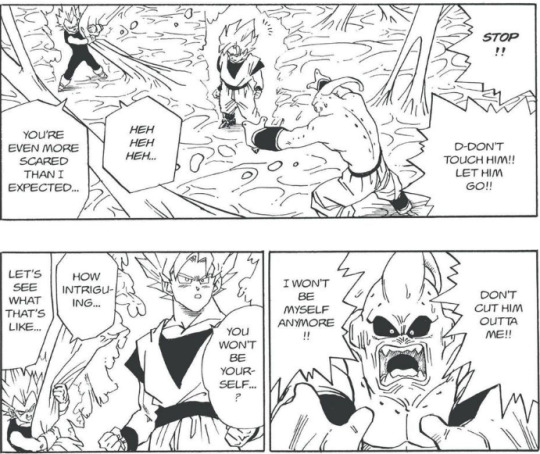
This is the foundation that Buu starts from: A killing machine programmed to destroy. But then he absorbed the Daikaioshin or The Great God of the World Kings and developed an intellect and personality.
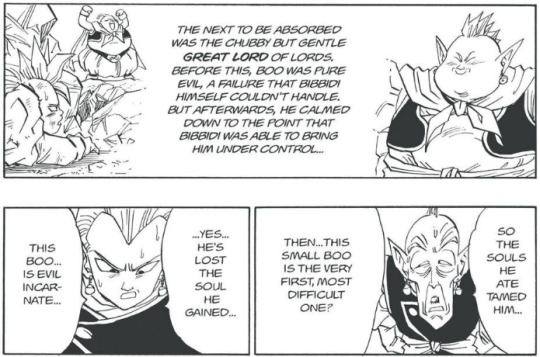
(Given that Dragon Ball's mythology is rooted in Japanese Buddhism, it's likely no coincidence that Daikaioshin and by association Fat Buu has a Buddha-like appearance.)
Fat Buu is a lot like Piccolo Jr., with the difference being that the reincarnated Piccolo was very adult-coded while Buu is clearly meant to be taken as a child. Nonetheless, he's the first aspect of Buu to be self-aware enough to become capable of moral agency. Daikaioshin's influence on his mind made him more intelligent, turning him from a mindless killing machine into an impulsive and easily influenced child.
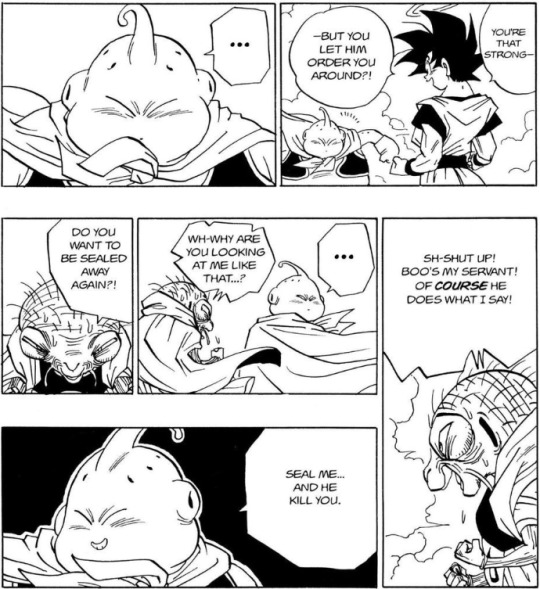
Look at him in that center panel. Just. Thinking about what Goku said. Mulling it over in his head. Like, he was onboard with this whole "Do what I say because I have power over you" thing but now that you mention it....
Goku does not get enough credit for being the one to kill Babidi. This rolled up to him. He straight-up ended Babidi with a question.
In this form, Buu does vile things, to be sure.
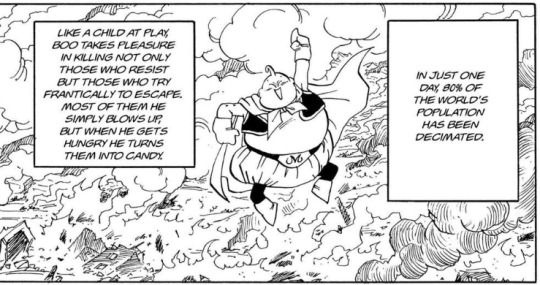
But as the text box says: He's a child at play. Majin Buu at this point has the moral complexity of a five-year-old. He's not really evil; He just... doesn't know better. He's never been taught better, and so his actions are almost paradoxical in nature.
Legit, one of my favorite chapters of the entire Buu arc is when he encounters a starving blind kid and heals his blindness so he can be properly afraid of him. Then winds up making friends.
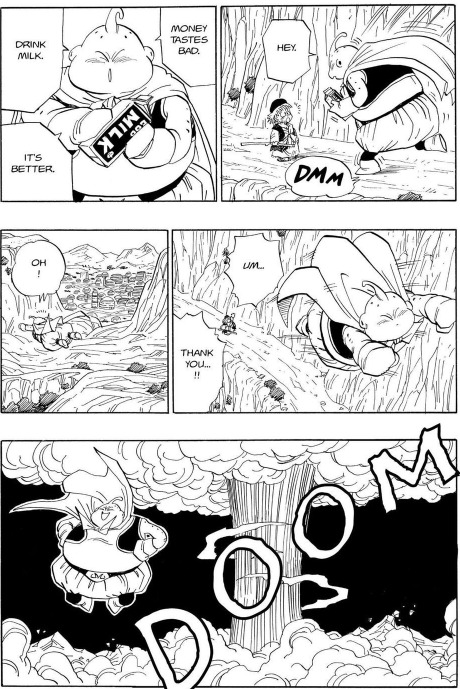
Nuked that town and also he made that milk by Candy Beaming a human being so that's horrifying. And yet, you can see the peculiarity of his villainy even this early. Buu craves approval, even though he's been taught to care only about destruction and carnage.
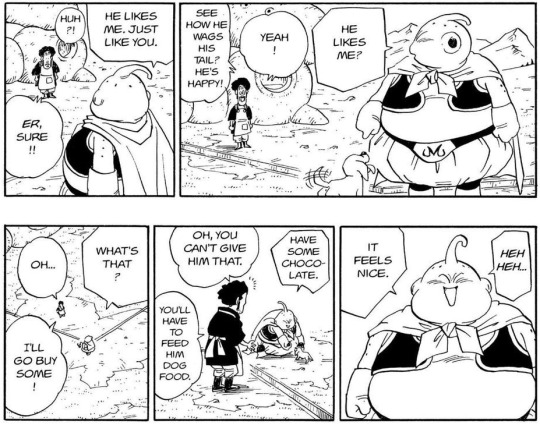
Craves it so much that bringing an end to his carnage is as simple as asking him to stop.

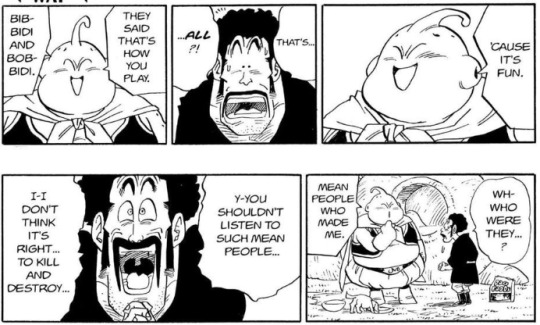
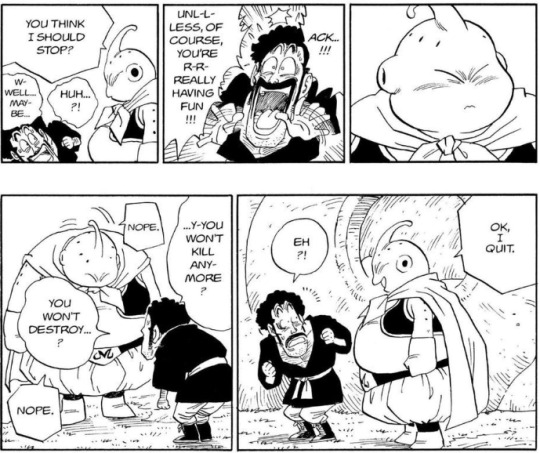
And that's that. It's really not so much a redemption story as it is a child being taught better. Mr. Satan was the first person ever to actually say to this thinking form of Majin Buu, "Hey, that's bad. Don't do that. It's bad."
The first person to try parenting him instead of fighting him. (To be fair, it would have been impossible to parent him before Goku's semantic homicide of Babidi.)
Once this form of Buu returns in the final battle, he still isn't really a moral actor. He becomes a protagonist out of nepotism.

(Yeah, Viz uses Hercule instead of Mr. Satan because they hate fun. HAIL SATAN.)
After Satan asks him to please stop being bad, Buu becomes morally neutral. He's effectively Satan's uncontrollable toddler. He doesn't comprehend high-minded ideals of good or evil; He's an emotional and impulsive creature who cares about his bestie.
Which, to be honest, puts him in good company. Most of the cast of Dragon Ball are ex-assholes who don't so much have a traditional redemption story, but instead just... stop doing the thing. They used to be assholes, and then, for one reason or another, they stopped.
It's actually something I find really grounded about the way Dragon Ball handles its cast. Most of the characters in the series are like this, to varying degrees of past heinousness. There's none of the gravitas of atonement or redemption questing or the Big Moment of Redemption. They just. Stop being assholes and become some guy.
Piccolo is a rare exception.
52 notes
·
View notes
Text
Just finished my thoughts on Blood of Zeus season 2 (WILL CONTAIN SPOILERS)
The music makes me feel so nostalgic for some reason?! It reminds me of a bunch of amazing Sword and Sandal movies, Jason and the Argonauts, Clash of the Titans (80's) and anything the Universal studios has produced pre-2000's. It's so beautiful. I know it's not as traditional as some recent media has done but it epitomizes more classic depictions of Greek mythology that most people began liking from early childhood.
The first three episodes were a little weird for some reason. Buuuuut it started to get better.
Hades and Persephone actually has a pretty good reason to be stirring so absolute tea. Also ZAGREUS AND MELINOE ARE THERE POOR BIBIS.
I do... fucking...not...want to assume Hermes cut Heron's life line but why am I getting that weird sneaking suspicion he did??? Maybe Gaia is suspect too.
I LOVE the inclusion of more gods, even if some of them were just cameos.
The mischaracterization of Ares, Demeter and Hades to some extent was a fuckn whiplash. Like Ares.... GOING TO RAPE PERSEPHONE? Hell fucking no that's Heresy. Demeter being ruthless for no reason seemed very off too. Hades is most suppose to be reasonable, it felt somehow forced. I don't know....but it was more interesting then the forced conflicts between Hera and almost half of everyone else.
Hera's redemption was a bit rushed...but I actually appreciate that at least someone isn't trying to make things more complicated.
THE USE OF CORDYCEPS FUNGUS WILL NEVER NOT BE FUCKING HORRIFYING AS SHIT LIKE DAAAAAAAMN DEMETER THATS NURGLE SHIT.
Seraphim is...ugh...there....I mean yey he's becoming more redeemable...but....it feels ....forced??? I don't know it's the second season I could being annoying about it.
The sphinx design was perfect! Her riddles were bullshit tho.
Gorgo seems like she's a reference to Medusa the Gorgon in the Ovid version of the myth. Mostly because of the root word 'gorgo'.
I found the inclusion of the Three Kings of the Underworld to be both interesting yet a bit ironic. Considering each king is a known character from the myths that were guilty of equally terrible things. It would be interesting to have them be ancient pre-Hellenic kings.
Gaia was the coolest grandma ever....and I don't blame her for being epic as fuk frustrated to the point of summoning Typhon.
9/10 🏺, I recommend watching this show to get a perfect understanding of how to play around with a retelling without 100% completely misunderstanding the myth
32 notes
·
View notes
Text
Trope chats: redemption arcs

The redemption arc is a widely used trope in storytelling across different media forms such as literature, film, television, and video games. This narrative device involves a character's journey from a morally questionable or villainous position to one of redemption, often by acknowledging their faults, seeking forgiveness, and taking action to atone for their wrongdoings. The redemption arc is a powerful literary device that allows creators to explore complex themes of morality, growth, and transformation. This essay will delve into the evolution of the redemption arc, its pitfalls, uses as a literary device, and its societal influence and impact.
The redemption arc has been a staple of storytelling for centuries, with roots in ancient literature and religious texts. Key aspects of its evolution include:
Classical Archetypes: In classical literature, redemption arcs can be found in works such as Dante's Divine Comedy, which follows the protagonist's journey through Hell, Purgatory, and Heaven. Similarly, in Greek mythology, figures like Heracles seek redemption through their heroic deeds.
Religious Narratives: Many religious narratives feature themes of redemption, such as the Christian story of salvation and forgiveness through Christ's sacrifice. These stories have influenced broader cultural conceptions of redemption.
Literary Movements: The redemption arc evolved with literary movements such as Romanticism and the Gothic tradition, which often explored the complexities of human nature and the potential for redemption and transformation.
Modern and Contemporary Interpretations: In contemporary media, the redemption arc is a versatile trope found in genres ranging from crime dramas to superhero stories. It has been adapted to reflect modern values and ethical considerations.
While the redemption arc can be a compelling narrative device, it also presents certain pitfalls:
Lack of Depth: If the arc is rushed or lacks depth, it may feel unearned or forced, making it difficult for the audience to empathize with the character's transformation.
Simplified Morality: Redemption arcs can sometimes oversimplify moral complexities, presenting a binary view of good and evil without adequately exploring gray areas.
Perpetuation of Harmful Stereotypes: In some cases, redemption arcs can perpetuate stereotypes or reinforce problematic narratives, particularly if the character's redemption is tied to harmful tropes such as the "tragic backstory."
Redemption Without Consequences: In some stories, characters may achieve redemption without facing the full consequences of their past actions, which can undermine the seriousness of their transformation.
The redemption arc is a versatile literary device that serves several purposes:
Character Development: Redemption arcs allow for rich character development, showcasing a character's growth and transformation over time.
Exploration of Themes: This trope provides a vehicle for exploring themes such as forgiveness, accountability, and the potential for change.
Emotional Engagement: Audiences often find redemption arcs emotionally engaging as they witness a character's journey from darkness to light.
Social Commentary: Redemption arcs can offer social commentary on issues such as criminal justice, rehabilitation, and the possibility of second chances.
The redemption arc has a significant influence on societal perceptions and values:
Rehabilitation and Forgiveness: Stories of redemption can shape attitudes toward rehabilitation and forgiveness, both on an individual and societal level.
Second Chances: Redemption arcs emphasize the importance of giving individuals a second chance, reflecting and reinforcing societal values of compassion and understanding.
Ethical and Moral Reflection: Through redemption arcs, audiences are prompted to reflect on their own beliefs and ethical considerations, fostering greater empathy and awareness.
Normalization of Transformation: Redemption arcs normalize the idea of personal growth and transformation, suggesting that individuals have the potential to change for the better.
The redemption arc is a powerful and enduring trope in storytelling that has evolved over time to reflect changing societal values and ethical considerations. While it offers rich opportunities for character development and emotional engagement, it also carries potential pitfalls that creators must navigate carefully. By understanding the nuances of the redemption arc, storytellers can craft compelling narratives that resonate with audiences and prompt reflection on themes of morality, forgiveness, and the possibility of redemption.
#writeblr#writers of tumblr#writing#booklr#bookish#fantasy books#creative writing#book blog#ya fantasy books#ya books#fiction writing#writers#female writers#how to write#writers and poets#writers on tumblr#am writing#fantasy writer#story writing#teen writer#tumblr writers#tumblr writing community#writblr#writer problems#writer stuff#writerblr#writers corner#writers community#writers life#writerscommunity
20 notes
·
View notes
Text
misdeliria's romance manhwa rec list
Of course, this is far from the number of manhwas I've read, but here are the highlights. Comment your recs if I don't have it here or my inbox is open!

[MANHWACLAN FAVORITES] This website may produce a lot of ads, so for the best experience, download an ad blocker from the app store {i.e., adguard}
Death Is The Only Ending For The Villainess [ ongoing - currently: 162 chapters ] Penelope Eckart reincarnated as the adopted daughter of Duke Eckart and the villainess of a reverse harem dating sim.
I love this manhwa. FL has to navigate how to capture the hearts of the MLs, who all despise the villainess.
Lee Seob’s love [ ongoing - currently: 56 chapters ] The epic office romance between Tae Lee Seob, who doesn’t want to do anything, and Kang Minkyung, who must somehow succeed!
This super cute office romance has me in a chokehold. The art is beautiful, and the MLs moral dilemma is a personal issue he's trying to work through while chasing the FL.
I Can’t Be This Stupid [ completed - currently: 91 chapters ] Doha takes an active role as Rowoon’s secret love consultant, and a romantic life together begins.
A super cute slice-of-life modern romance between two kids on opposite ends of the wealth class—with a little splash of telepathy.
The Villainess Lives Twice [ ongoing - currently: 217 chapters ] But in return for her devotion, Artizea got betrayed. And the one that reaches out his hand to save her from the verge of death is her righteous enemy, Grand Duke Cedrick.
Another unforgettable historical romance where the FL is transported into the villainess' role. Part of the fan translation is messy towards the 100-chapter milestone, but the plot holds up, and I continuously root for the leads in this one.
I'm Not The Final Boss' Lover [ ongoing - currently: 62 chapters ] Jun is prepared to guide Fabian through the second playthrough to the true ending when… Fabian abandons her. Now Grand Duke Mayer Knox—captain of the Dark Knights and the secret final boss—is determined to have her join his party.
I was a total dork about this one. There's a lot of gamer-talk from the FL with historical/fantasy elements. The romance is also perfect (ML falls first, AND harder)
I Thought It's A Common Possession [ ongoing - currently: 77 chapters ] If I was going to die anyway, according to the original, then let’s give a kiss to my handsome husband!
Another villainess isekai (I have a serious obsession). Something about how the FL gets so angsty because they're forced into a role where everyone hates them, and somehow, she manages to get the ML to fall in love with her. UGH, poetry.
The Redemption of Earl Nottingham [ ongoing - currently: 36 chapters ] Madelyn’s husband Ian was left broken after the war, and in turn, made her life a living hell. Fleeing her doomed marriage, she meets a tragic end.
Reincarnation trope! Ahh, love this one. It says it contains mature content, but I don't remember seeing anything—just keep it in mind before you decide to read this one. With miscommunication and pining, the ML really isn't a bad guy; he's just a traumatized eldest child.
Call Me The Devil [ ongoing - currently: 107 ] A plastic surgeon by day and a devil by night, Hyunshin has the power to seduce anyone with his eyes, but somehow, his irresistible temptation does not work on “Lee Na”, who suddenly appeared one day.
The ML is a devil in this one. I loved it so much. The supporting characters really make this one, though. The little family, all of them together, makes my heart palpitate.
My God Is A Lustful Man [ ongoing - currently: 50 chapters ] Hye-sal, a timid ethics teacher who has lived her whole life without desires, finds that a neighbor who exudes desire and pleasure has moved in next door.
Dionysus is the ML in this, and this Greek mythology manhwa adaption is peak. I love the pining and mythology references. Initially, I found this comic on Webtoon, but I found a better source to read from.
I Can't Wait To Eat You [ ongoing - currently: 59 chapters ] I swore to resent her all my life when I was a kid, so I’m going to stick around to make her life impossible, I’ll make sure to eat her happiness away.
OOO, the ML in this one starts off as a little shit, but he definitely grows on you once he realizes his feelings and becomes the best boyfriend/boss ever.
Extroversion of an Immortal [ ongoing - currently: 55 chapters ] A fairy ‘Cheon Moran’, who killed a woodcutter for stealing her wings and lived like a celebrity while trapped in the human world, was discovered by ‘Sa Jeha’, a detective in charge of a murder case in which she was involved.
This one took a while for me to get attached to because I was constantly getting cliffhangers. I really like what it is so far. I'm heavy into speculating what the angst will become, but so far, the characters are so pretty, and that's my main argument.
Pure Love Operation [ ongoing - currently: 108 chapters ] I saw my boyfriend kissing my best friend. if that wasn’t enough, I was with a guy whose guts I hate from my class, Go Eun-Hyuk.
I'm sure many people have already seen this one, but if you haven't, you should. This was one of the stories that got me back into reading webcomics. The art is beautiful, the plot is gripping, and the romance is literally to die for (because I will never experience Dohwa falling in love with me and I'm so envious of Soo-Ae).
What I Decided To Die For [ completed - currently: 98 chapters ] Cha Gyeol, who met Ji Oh while having all sort of bad thoughts, is completely swoon over by Ji Oh with her dazzling smile. However, the people around Cha Gyeol are somehow dangerous for her to go head over heels with him.
This modern reincarnation romance is so good. I was experiencing turmoil rooting for the ML but it all played out right in the end and I should be so happy for the author LOL

[ WEBTOON FAVORITES ] As some of you may know, Webtoon stories aren't always available on other sites, so... The following links will take you to Webtoon's website.
Eaternal Nocturnal [ completed - currently: 101 chapters ] When Eve is visited one night by a mysterious apparition, she finds that her chronic insomnia is miraculously cured. Meanwhile Dae, the dream eater, finds himself unexpectedly and unwillingly drawn to Eve.
I love the author, instantmiso. She also wrote Where Tangents Meet and Siren's Lament, both are completed and I've read. The pining and Dae's character were so satisfying.
The Mafia Nanny [ ongoing - currently: 45 chapters ] Being an Elite Nanny is simple: protect the charge, obey the principle, and don’t get emotionally attached. Easier said than done when Davina’s first client is a dangerously compelling Venetian underboss who’s determined to get under her skin.
The leads in this one have me BARKING. I love a good mafia romance, and this manhwa adaption has me sat and waiting every week for the update. Davina is a badass, and her Venetian employer is such a good father. Some (his son) might even call him daddy. Hehe
Down To Earth [ ongoing - currently: 203 episodes ] Kade lives his average life alone and undisturbed... until a cute alien girl crashes into his backyard!
I initially read this one because my friend kept harping me about it. It's a very cute, wholesome romance between a depressed dude and a sweet, gorgeous, lovable alien girl who crashes on Earth.
Of Swamp And Sea [ ongoing - currently: 100 chapters ] When a monster hunt gone wrong sets two strangers on the same path, they discover their relationship may be more than strictly professional.
I'll be honest and say I am not entirely caught up on this one, only because it went on hiatus after I got caught up. The relationship between the FL and ML was a little off to me at first because I really thought the FL was a teenager until it was revealed she was in her twenties. But, overall, the development between them is lovely.
I Love Yoo [ ongoing - currently: 254 episodes ] Dogged by pain and misfortune from the very beginning, Shin-Ae decides she wants nothing to do with people nor anything to do with romance.
Another extremely popular one, which should take first priority if you haven't started yet. A modern romance with modern-day problems, but the anguish that each character individually experiences keeps me hooked. I hope they all work through their issues and become their happiest selves. Also, the dad is a little bitch boy.
Act Like You Love Me [ completed - currently: 150 chapters ] When a mix-up at a temp job has her spending a day as famous actor Doyun Nam’s personal assistant, she takes her anger out on a doll... which turns out to have the magical ability to control him at her every whim.
This one was so, SO good. I really loved the second ML, but of course, the primary ML is still a heartthrob. The FL was such a lucky girl to have two successful hotties after her.
I could add a lot more, but this is a good start! Happy reading! ❤️
#manhua#manhwa#manga#manhwa recommendation#manhwua#manhwa review#webtoon#webtoon recommendation#webtoon review#webcomic series#webcomic#manhua recommendation#manwha
7 notes
·
View notes
Text
youtube
The Fascination and Terror of Medusa: A Journey into Greek Mythology (Roman version)
Introduction to the Legend of Medusa
Medusa is one of the most fascinating and terrifying figures in Greek mythology. Known as one of the three Gorgons, Medusa is the only mortal among her sisters, Stheno and Euryale. Her most notable representation is that of a woman with snakes in place of hair, capable of turning anyone who meets her gaze to stone. The legend of Medusa has spanned centuries, influencing art, literature, and popular culture.
According to mythology, Medusa was not always a monstrous creature. Originally, she was a beautiful young woman, a priestess in the temple of Athena. However, her beauty attracted the attention of Poseidon, the god of the sea, who seduced her in the sacred temple. This sacrilegious act aroused Athena's wrath, who, to punish Medusa, transformed her into a monster. Her snake hair and petrifying power are the result of this transformation, which forever altered her fate.
Medusa is a complex figure rich in symbolism. On one hand, she represents beauty and innocence corrupted by violence; on the other, she embodies female power and vengeance. Her image has inspired numerous works of art, from ancient Greek amphorae to Renaissance paintings, and modern cinematic interpretations. Medusa continues to evoke interest and fear, remaining one of the most enigmatic and powerful figures in Greek mythology. Her legend is a powerful tale of transformation, punishment, and ultimately, resilience.

The Origins of Medusa
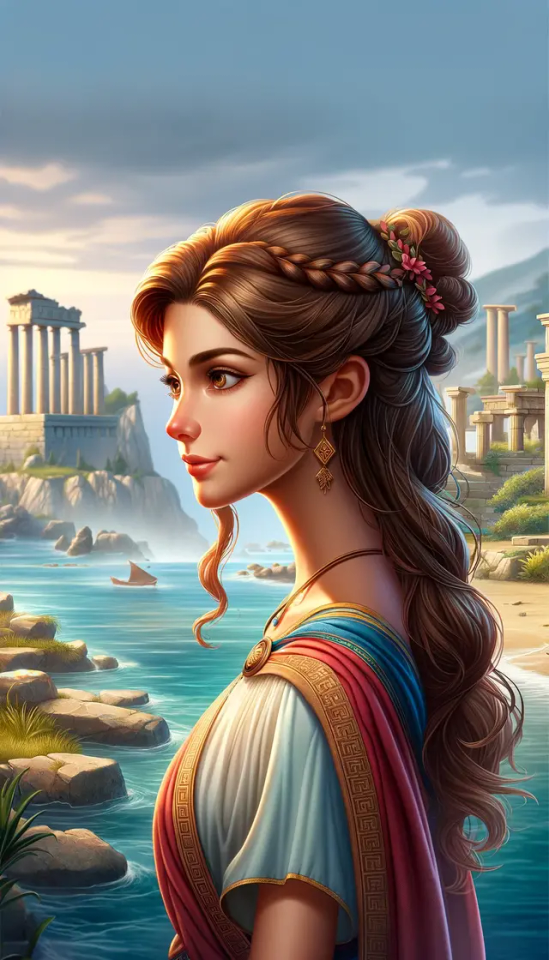
The origins of Medusa are deeply rooted in Greek mythology, where beauty and tragedy intertwine in a captivating and complex story. Initially, Medusa was not the monstrous creature everyone knows but a beautiful young woman known for her extraordinary beauty. She was one of the three Gorgons, daughters of the sea deities Phorcys and Ceto. Unlike her sisters Stheno and Euryale, who were immortal, Medusa was mortal.
Medusa became a priestess in the temple of Athena, the goddess of wisdom and war, requiring a vow of chastity and devotion. However, her life took a dramatic turn when Poseidon, irresistibly attracted by her beauty, seduced her in Athena's temple, an act of great sacrilege. Athena, furious at the desecration of her sanctuary, transformed Medusa into a monster. Her beautiful hair was turned into venomous snakes, and anyone who met her gaze would be immediately turned to stone. This radical transformation not only punished Medusa but isolated her from the world, making her a figure of terror.
Medusa's punishment can be interpreted in various ways. Some see Athena as a goddess who protected her temple and punished the violation of its sanctity. Others view the punishment as a symbol of divine anger and vengeance against corrupted innocence. Medusa's story reflects the complexities of relationships between mortals and gods, and the cruel irony of her fate continues to provoke discussions among scholars and mythology enthusiasts.
Despite her transformation into a monster, Medusa remains a tragic and captivating figure. Her story highlights universal themes of beauty, power, punishment, and redemption, making her one of the most intriguing figures in Greek mythology. Over the centuries, Medusa has become a powerful symbol, whose legend continues to inspire and frighten, representing an important chapter in the rich tapestry of Greek mythology.
The Transformation of Medusa: From Beautiful Priestess to Monster
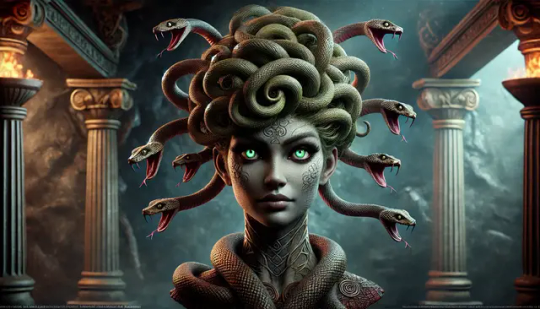
The transformation of Medusa from a beautiful priestess to a petrifying monster is one of the most famous metamorphoses in Greek mythology, laden with symbolic and moral meanings. Originally, Medusa was a beautiful young woman known for her extraordinary beauty. As a priestess of Athena, she was bound by a vow of chastity, devoutly serving the goddess of wisdom and war in her temple. Her life took a dramatic turn when she caught the attention of Poseidon, the god of the sea.
Poseidon, captivated by Medusa's beauty, seduced her in Athena's temple, a sacrilegious act that violated the sanctity of the place. Athena, enraged by the desecration of her temple, transformed Medusa into a monster, drastically altering her physical appearance and marking her future existence.
Medusa's metamorphosis was complete: her beautiful hair was turned into venomous snakes, and her gaze became so powerful that it could turn anyone to stone. This new aspect made Medusa a feared and isolated figure, relegated to the fringes of the known world. Her transformation is rich in symbolism: snakes, often associated with wisdom and rebirth, here become emblems of terror and death, while her petrifying gaze represents the paralyzing effect of fear.
This punishment can also be seen as a critique of female beauty and its perception in society. Medusa, once admired for her beauty, became a monster because of the very quality that made her special. The myth can be interpreted as a reflection on the fragility of beauty and its potential to provoke envy and destruction.
Despite her terrible transformation, Medusa remains a tragic figure, symbolizing corruptible beauty and the power of divine vengeance. Her story continues to be told and reinterpreted, an eternal reminder of the power of the Greek gods and the consequences of transgressions in their capricious and merciless world.
Medusa and Perseus: The Hero and the Monster
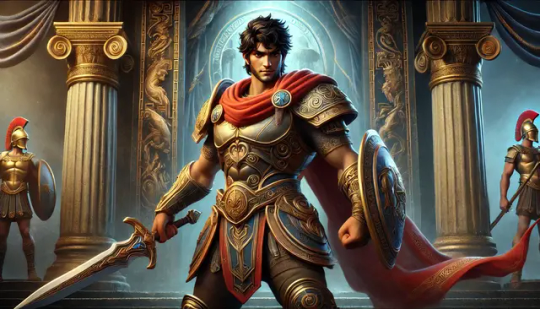
Medusa's story is inextricably linked with that of Perseus, one of the most famous heroes in Greek mythology. Their legend, rich in adventures and twists, tells of courage, cunning, and divine interventions, culminating in one of the most iconic battles between a hero and a monster.
Perseus was the son of Danae and Zeus, conceived under extraordinary circumstances. Danae had been imprisoned in a bronze tower by her father, Acrisius, king of Argos, due to a prophecy that foretold he would be killed by his grandson. However, Zeus, transforming into a shower of gold, reached Danae and made her the mother of Perseus. When Acrisius discovered his grandson's birth, he locked Danae and Perseus in a chest and cast them into the sea. The two survived and were taken in on the island of Seriphos.
Here, Perseus grew up to be a brave young man. His adventure began when the king of Seriphos, Polydectes, who was in love with Danae, sought to get rid of Perseus by sending him on an apparently impossible mission: to bring back the head of Medusa, the most fearsome of the Gorgons. Perseus accepted the challenge and received divine assistance for the task.
Athena and Hermes, the gods who protected heroes, provided Perseus with essential tools: a reflective shield, an adamantine sickle, winged sandals, a kibisis (a magical bag), and Hades' helm, which rendered him invisible. With these gifts, Perseus traveled to the land of the Gorgons.
Medusa lived with her sisters in a remote and inaccessible place. Perseus, using the reflective shield to avoid her petrifying gaze, approached Medusa while she slept and, with a precise stroke of the sickle, decapitated her. From Medusa's mortal wound sprang two extraordinary creatures: the winged horse Pegasus and the giant Chrysaor, symbols of beauty and power emerging from chaos and destruction.
Perseus not only succeeded in his mission but also used Medusa's head as a weapon, exploiting its petrifying power on numerous occasions. Eventually, he gave the head to Athena, who placed it on her shield, the aegis, as a symbol of protection and terror.
The story of Perseus and Medusa is rich in symbolic meanings. Perseus represents the archetypal hero, capable of overcoming impossible challenges through courage, cunning, and divine help. Medusa, on the other hand, embodies terror and corrupted beauty, a creature who, despite being a victim, becomes an instrument of destruction.
This legend continues to be an inexhaustible source of inspiration in culture, art, and literature, reminding us of the complex dynamics between heroes, monsters, and gods in the fascinating world of Greek mythology.

Symbolic Interpretations of Medusa
Medusa is a character steeped in symbolism, with interpretations varying over time and cultures. In Greek mythology, she represents divine punishment and the transformation from beauty to monstrosity, a reflection on the fragility of beauty and the destructive power of divinity. Her ability to petrify with her gaze can be seen as a metaphor for the paralyzing power of fear and terror. In psychological terms, Medusa can be interpreted as a symbol of repressed female power and vengeance. Carl Jung, the Swiss psychologist, saw Medusa as an archetype of the "terrifying mother" and female destructive power. In contemporary culture, Medusa is often revisited as an emblem of resilience and female strength, an icon of empowerment challenging traditional gender roles.
Medusa's Influence in Popular Culture
Medusa's influence in popular culture is vast and enduring, spanning literature, art, cinema, and fashion. In literature, she has appeared in works by authors such as Ovid and Dante, continuing to inspire contemporary writers. In art, her image has been immortalized by artists like Caravaggio and Rubens. Cinema and television have repeatedly revisited the myth of Medusa, with interpretations ranging from epic films like "Clash of the Titans" to TV series and video games. Fashion has adopted Medusa's iconography, with the brand Versace using her head as its logo, symbolizing beauty, power, and mystery. Medusa continues to be a powerful cultural symbol, capable of evoking strong emotions and stimulating deep reflections on human nature and society.
#athena#cultural influence#Gorgons#Greek Mythology#medusa#Perseus#Poseidon#symbolism#mythology#youtube#digital art#fantasy#videos#folklore#mythical creatures#Youtube
8 notes
·
View notes
Text
Botticelli’s Map of Hell
Our modern vision of hell is deeply rooted in the literary and artistic works of the past, with one of the most significant contributions being Sandro Botticelli’s Map of Hell. This masterpiece, created approximately 700 years ago, offers a visual representation of the infernal realms as imagined by Dante Alighieri in his epic poem, "The Divine Comedy." The symbiotic relationship between Dante's literary creation and Botticelli's artistic interpretation has profoundly influenced how we perceive hell even today.

Dante Alighieri, an Italian poet, writer, and philosopher, penned "The Divine Comedy" in the early 14th century. The poem is divided into three parts: Inferno (Hell), Purgatorio (Purgatory), and Paradiso (Paradise). In Inferno, Dante embarks on a harrowing journey through the nine circles of hell, guided by the Roman poet Virgil. Each circle represents a different sin and its corresponding punishment, meticulously detailed by Dante’s vivid imagination and profound theological insights.
Dante’s vision of hell was revolutionary. It combined classical mythology, Christian theology, and medieval philosophy, creating a complex and terrifying afterlife landscape. His work not only reflected the religious beliefs of his time but also influenced future generations' understanding of sin, punishment, and the moral consequences of earthly actions.
About 150 years after Dante’s death, Sandro Botticelli, a renowned Renaissance painter, undertook the ambitious project of illustrating "The Divine Comedy." Among his works, the Map of Hell stands out as a detailed and haunting depiction of Dante’s infernal realms. Botticelli’s illustration, created around 1480, serves as a visual guide to the intricate and layered structure of hell described by Dante.
Botticelli’s Map of Hell is a parchment drawing that meticulously outlines the descending circles of hell, each with its unique torments and sinners. The precision and detail in Botticelli’s work capture the essence of Dante’s narrative, making the abstract horrors of hell more tangible and accessible to the viewers. His ability to convey the emotional and physical anguish of the damned souls adds a visceral quality to Dante’s literary vision.
The collaboration between Dante’s literary genius and Botticelli’s artistic mastery has had a lasting impact on our cultural and religious conception of hell. Even today, many of the common images and ideas associated with hell—such as fire and brimstone, eternal torment, and the hierarchical structure of punishments—can be traced back to Dante’s Inferno and Botticelli’s Map of Hell.
Modern depictions of hell in literature, art, and popular culture often draw inspiration from these medieval works. Whether in horror films, graphic novels, or theological discussions, the influence of Dante and Botticelli is unmistakable. Their portrayal of hell as a place of moral reckoning and divine justice continues to resonate with contemporary audiences, reflecting enduring questions about sin, punishment, and redemption.
Sandro Botticelli’s Map of Hell, based on Dante Alighieri’s "The Divine Comedy," remains a cornerstone of our understanding of the infernal realms. The interplay between Dante’s poetic vision and Botticelli’s artistic interpretation has shaped our collective imagination, defining hell for over seven centuries. As we continue to explore and reinterpret these works, their profound impact on our perception of the afterlife endures, reminding us of the power of art and literature to shape our deepest beliefs and fears.
#Dante Alighieri#Sandro Botticelli#The Divine Comedy#Inferno#Map of Hell#Medieval literature#Renaissance art#Hell#Dante's Inferno#Religious art#Christian theology#Historical art#Literary classics#Art history#Dante and Botticelli#Cultural influence#Depictions of hell#Dante's circles of hell#Artistic interpretation#Moral consequences#today on tumblr#new blog
8 notes
·
View notes